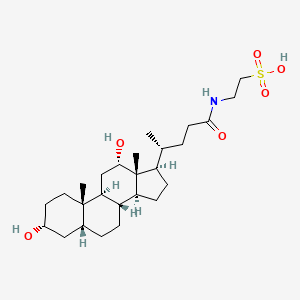| MeSH term | MeSH ID | Detail |
|---|---|---|
| Colitis, Ulcerative | D003093 | 24 associated lipids |
| Adenocarcinoma | D000230 | 166 associated lipids |
| Colonic Neoplasms | D003110 | 161 associated lipids |
| Body Weight | D001835 | 333 associated lipids |
| Cholestasis | D002779 | 23 associated lipids |
| Birth Weight | D001724 | 23 associated lipids |
| Shock, Hemorrhagic | D012771 | 4 associated lipids |
| Gastrointestinal Hemorrhage | D006471 | 27 associated lipids |
| Tay-Sachs Disease | D013661 | 2 associated lipids |
| Fetal Resorption | D005327 | 15 associated lipids |
Taurodeoxycholic acid
Taurodeoxycholic acid is a lipid of Sterol Lipids (ST) class. Taurodeoxycholic acid is associated with abnormalities such as Ischemia and Wiskott-Aldrich Syndrome. The involved functions are known as Cell Proliferation, Transcriptional Activation, Phosphorylation, Anabolism and Biochemical Pathway. Taurodeoxycholic acid often locates in Body tissue, Epithelium, Blood, Mucous Membrane and Hepatic. The associated genes with Taurodeoxycholic acid are NOX5 gene, GPBAR1 gene, NR1H4 gene and SLC33A1 gene. The related lipids are cholanic acid, taurolithocholic acid 3-sulfate, Sterols, 7-dehydrocholesterol and tauromuricholic acid.
Cross Reference
Introduction
To understand associated biological information of Taurodeoxycholic acid, we collected biological information of abnormalities, associated pathways, cellular/molecular locations, biological functions, related genes/proteins, lipids and common seen animal/experimental models with organized paragraphs from literatures.
What diseases are associated with Taurodeoxycholic acid?
Taurodeoxycholic acid is suspected in Ischemia and other diseases in descending order of the highest number of associated sentences.
Related references are mostly published in these journals:
| Disease | Cross reference | Weighted score | Related literature |
|---|
Possible diseases from mapped MeSH terms on references
We collected disease MeSH terms mapped to the references associated with Taurodeoxycholic acid
PubChem Associated disorders and diseases
What pathways are associated with Taurodeoxycholic acid
There are no associated biomedical information in the current reference collection.
PubChem Biomolecular Interactions and Pathways
Link to PubChem Biomolecular Interactions and PathwaysWhat cellular locations are associated with Taurodeoxycholic acid?
Visualization in cellular structure
Associated locations are in red color. Not associated locations are in black.
Related references are published most in these journals:
| Location | Cross reference | Weighted score | Related literatures |
|---|
What functions are associated with Taurodeoxycholic acid?
Related references are published most in these journals:
| Function | Cross reference | Weighted score | Related literatures |
|---|
What lipids are associated with Taurodeoxycholic acid?
Related references are published most in these journals:
| Lipid concept | Cross reference | Weighted score | Related literatures |
|---|
What genes are associated with Taurodeoxycholic acid?
Related references are published most in these journals:
| Gene | Cross reference | Weighted score | Related literatures |
|---|
What common seen animal models are associated with Taurodeoxycholic acid?
There are no associated biomedical information in the current reference collection.
NCBI Entrez Crosslinks
All references with Taurodeoxycholic acid
Download all related citations| Authors | Title | Published | Journal | PubMed Link |
|---|---|---|---|---|
| Hismiogullari AA et al. | Isolation and biochemical analysis of vesicles from taurohyodeoxycholic acid-infused isolated perfused rat livers. | 2013 | World J. Gastroenterol. | pmid:24115821 |
| Cao W et al. | Expression of bile acid receptor TGR5 in gastric adenocarcinoma. | 2013 | Am. J. Physiol. Gastrointest. Liver Physiol. | pmid:23238937 |
| Asaro F et al. | 23Na and 35/37Cl as NMR probes of growth and shape of sodium taurodeoxycholate micellar aggregates in the presence of NaCl. | 2013 | J Colloid Interface Sci | pmid:23127873 |
| Heinen CA et al. | Ion pairing with bile salts modulates intestinal permeability and contributes to food-drug interaction of BCS class III compound trospium chloride. | 2013 | Mol. Pharm. | pmid:23750707 |
| Mencarelli A et al. | Dissociation of intestinal and hepatic activities of FXR and LXRα supports metabolic effects of terminal ileum interposition in rodents. | 2013 | Diabetes | pmid:23835330 |
| Lee HK et al. | Bile Acid Inhibition of N-type Calcium Channel Currents from Sympathetic Ganglion Neurons. | 2012 | Korean J. Physiol. Pharmacol. | pmid:22416216 |
| Zhang Y et al. | Dysfunction of organic anion transporting polypeptide 1a1 alters intestinal bacteria and bile acid metabolism in mice. | 2012 | PLoS ONE | pmid:22496825 |
| Kumar M et al. | Cholesterol-lowering probiotics as potential biotherapeutics for metabolic diseases. | 2012 | Exp Diabetes Res | pmid:22611376 |
| Okoli AS et al. | Effects of human and porcine bile on the proteome of Helicobacter hepaticus. | 2012 | Proteome Sci | pmid:22533459 |
| Karmakar S et al. | TLR4 and NKT cell synergy in immunotherapy against visceral leishmaniasis. | 2012 | PLoS Pathog. | pmid:22511870 |
